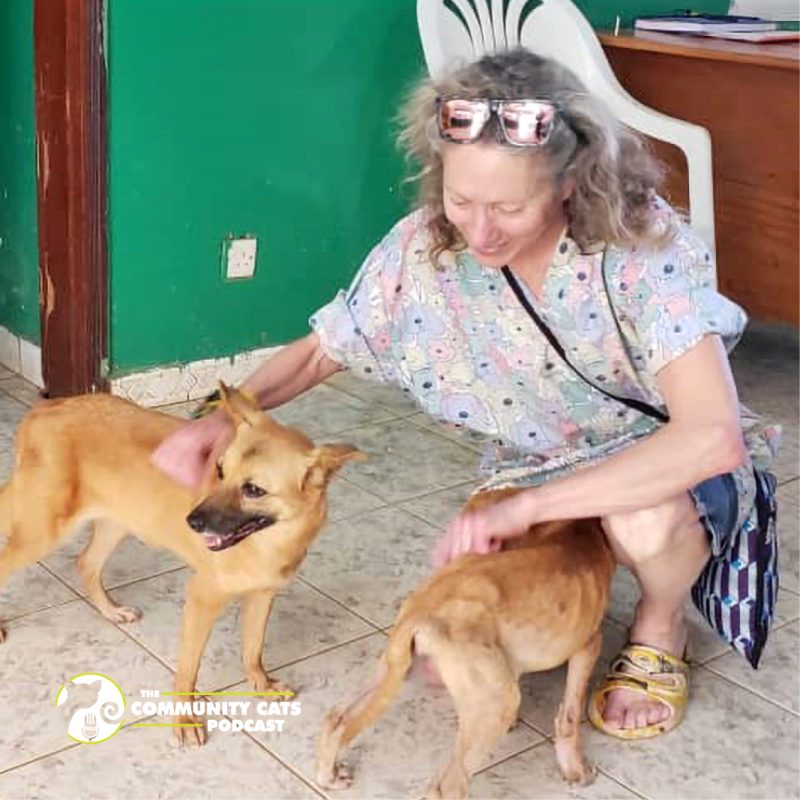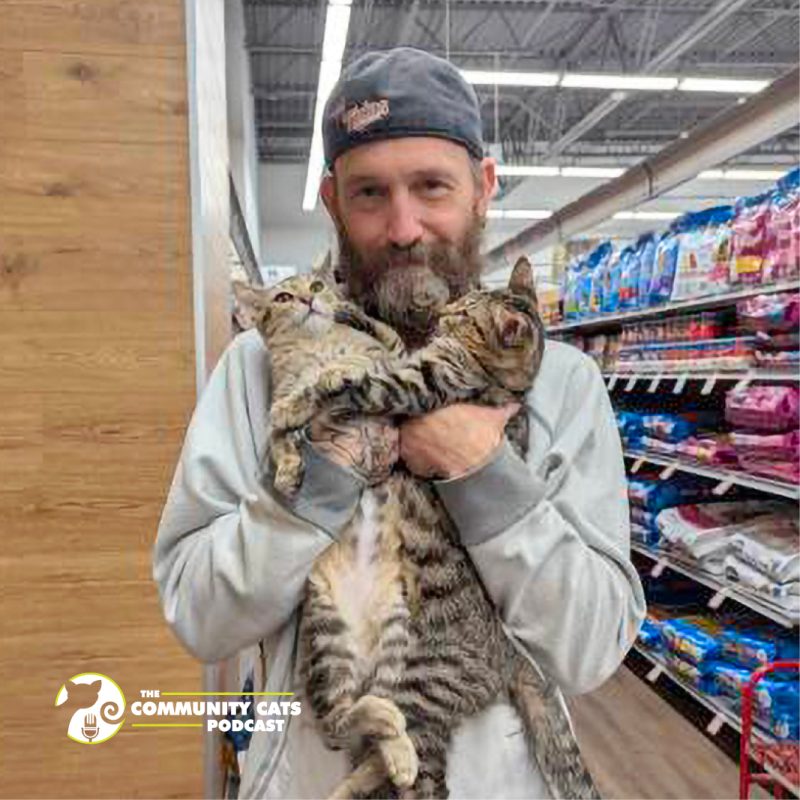Transcript, Episode #436: Bryan Kortis and Susan Richmond, Colony Care Taking Tips and Tricks Part 2
Kristen Petrie [00:00:02]
You’ve tuned in to the Community Cats Podcast. Ready? Let's go.
Stacy LeBaron [00:00:12]
Hey everybody, Stacy here. This is part two of the audio of our free webinar “Colony Caretaking Tips and Tricks”, webinar that we presented with the folks at Neighborhood Cats. There’s some incredible advice for folks that are taking care of kitties especially at this cold time of the year. For those of us that are in the northern part of the United States, it can be pretty chilly for our kitties and there’s some great tips here in this program. Our next live webinar will be in March and it’s trapper tips and tricks and feel free to join us then for the free webinar “Trapper Tips and Tricks”. You can sign up by going to communitycatspodcast.com/community-cat-care-training-education and get there from our website. Just go and search it out. Just put in tips and tricks and you’ll find everything that you want there.
This is the second part of a two-part series. So if you missed last week’s podcast, you might want to go back and listen to that episode first.
Today is the last day to sign up for the Online Cat Conference’s early-bird discount of sixty dollars. Please don’t miss this great event. We’re going to have incredible cat trivia, lots of prizes, lots of fun but lots of education too. We’re here to help you turn your passion for cats into action. Please join us and sign up today at communitycatspodcast.com. Thank you so much everybody and hope you have a safe New Year.
Brian Kortis [00:01:40]
Ok, so let’s talk about winter shelter, you know which is coming up in the colder climates at least in North America. You know, cats are very good at finding places to stay dry and out of the rain but they often do need help staying warm in the wintertime, in cold climates. So, what we want our winter shelters to have are three qualities that are all important and work in combination with each other. So, obviously, they need to be waterproof, right? They need to be well insulated. And that means that the material that they're made of is good at trapping heat. So, a very fancy looking winter shelter that is just a thin plastic with not very much insulation quality, you know, really doesn't do much good. And they need to have minimal airspace, so, as little empty space as possible. And the reason for the minimal airspace and the good insulation is because it's the cats themselves, their body heat, that acts as like a radiator. And when they're in there the insulation traps their body heat. If you have minimal empty air, that's less space that needs to be heated up. So the perfect shelter is crammed full of cats and insulating materials we'll talk about like straw, has very little empty space, and is a good thick insulation. And it is amazing how warm these shelters can be even in really bitter temperatures. We did a temperature test once and I don't remember the exact results and this was without a flap door on a winter shelter, and it was about a forty degree difference between the outside temperature and the inside. This particular shelter is a large Styrofoam box that's used for shipping fish. And it's wrapped in a thick, industrial- strength plastic and then the plastic is strapped on with heat-welded plastic straps. And if you're in the New York City area and you want to order some of them, you can go to that website wintercatshelter.com. This is the Neighborhood Cats winter shelter that is in the process of being built and it's made out of one sheet of two-foot by eight-foot wall insulation. It's Styrofoam, it's two inches thick and basically the plans use literally every square inch of that two-foot by eight-foot piece. It gets cut up and then silicone glued together. You can get fancy with wallpaper on the inside and a linoleum floor. The big trick with this shelter is, you really want to have access to a table saw if you can, so you get nice, straight cuts. If you use a hand saw, it's hard to not have uneven cuts, and then you end up using a ton of glue, in order to put the pieces together. But if you want the plans, it's on our website. We have a feral cat winter shelter page. So, go to neighborhoodcats.org and click on that link.
Here's another do-it-yourselfer, which is even simpler than the Neighborhood Cats one, and that's taking a storage bin. This is designed by a group called CSM Stray Foundation, in Queens, New York. And they just got some Styrofoam sheets, and that's about one inch thick and cut them. Line the interior walls, the floor, and they created a roof there, cut out a doorway and stuff the whole thing with straw. And the thing about this is, since you're not gluing the pieces together, you can cut this by hand. They don't have to be exactly tight fitting, they can be somewhat loose because you have the bin that's holding them together. Again, you can get these plans, as well, as a whole bunch of other do-it-yourself ideas on our website. And then finally, another do-it-yourself idea is just a simple Styrofoam box. This, I think, was used by Omaha Steaks but you can often find these at grocery stores, or fish stores, or, you know, pet stores, things like that. And they're excellent insulation and you just cut open a small doorway. You don't want to make the doorways any larger than necessary because you want to minimize the air coming in. And silicone glue the top on and give the thing a coat of deck paint to blend it into the environment and help protect the Styrofoam and you're good to go.
Now, some people like to put flaps on the doors and the way you could do that is you could get, you know, a nice thick piece of plastic or a rubber mat and attach it above the doorway. You could either duct tape it on or you could get what are called toilet bowl nuts and bolts. They're long basically, plastic screws and nuts and you can drill a hole or poke a hole in the material above the doorway and then attach the flap with the plastic screws and nuts and that's another way to do it. But if you're gonna use a flap, first put the shelters out and get the cats used to going in and out of them and then put the flap on and it should be something they can easily pull back and get in and out. But if you start with the flap on, they may or may not figure out that they want to go inside there and check it out. So, start without the flap and then add the flap later. To get the cats to go into the shelters, try sprinkling some catnip inside, you know something that will be attractive to them. Once they're in there and they get used to the environment, then they're much more likely to use the shelter.
If you want to buy one, and not deal with building your own, again, I'd refer you to Feral Villa. They make a great outdoor cat shelter that it's made of this semi kind of wood. I forget the exact name of it but it's a wood product, a wood-based product. You can see it's really well-made, it’s got a shingle roof. They send you all the pieces and you basically screw them together. It's not the lightest weight shelter that you're going to find and, I’m not sure what the price is right now, but it's, I think it's less than a hundred dollars. But if you have a small number of cats and you just want something sturdy and easy to put together, this is a good product for you.
Now I have noticed in the past two-three years or so, there's a lot of, all of a sudden the commercial world discovered there's a market for outdoor cat shelters, and you can go on to Amazon and do a search for cat shelters and you'll find a whole slew of them.
Unfortunately, the designers don't seem to have bothered to ever check with anybody who's done this work and they’re generally poorly designed. The materials they're made of, sometimes they're really good insulation, sometimes they're not. Often the doorways are way too large. Often, they have two doorways which create drafts. They put flaps on them, which are not really well-designed or they have too much airspace. So, this is the only commercially available cat shelter that we've found anyway, so far, that we would recommend. Now that question about two doorways usually comes up, and the theory is that the cats need an escape hatch. You know, so that if some threatening predator is coming through the front door, they can escape out the back. Now, that may be a real issue in certain areas, like maybe there's a lot of coyotes around or something like there's a real threat and the cats need that, but in the vast majority of situations, there is not an animal that's going to just barge in on a cat. You know, the cats have very sharp claws and teeth and it's not necessary in most situations. And the problem is when you have those two doors, you can create drafts and that can really decrease the warmth, the amount of warmth that's captured inside the shelter. So, don't do the two-door thing unless you have a real predator threat where you're caretaking.
So what about an emergency like a storm’s coming and you haven't got your shelters ready to go? You actually can use a cardboard box to get you through the storm. And the basic idea is you have two cardboard boxes, ones a little smaller than the other. You put the small one inside the large one, cut open doorways through both boxes and then stuff the space between the small box and the large box with newspaper. Newspaper is really good insulation. Once you've got that done, tape up the box, wrap it with a thick plastic like a drop cloth, three millimeters, and tape it on or tie it on and you've got a winter shelter that's gonna last a little bit until you can get a better one.
Placement is, again, it's just like feeding stations is real important, you want to keep it as discrete as possible. So that's why if you're using, like these people made the neighborhood cats’ winter shelter but they skipped the last step. They didn't paint it and you can see how it sticks. You know, maybe they didn't have time to, I don't want to criticize them but hopefully they painted them later because they stand out like a sore thumb, literally that bright pink, so try to keep it discreet. Keep the shelters close to the feeding station so that in really bad weather the cats do not have to travel very far, if that's possible. Now you can also see in this photo how they placed the winter shelters so that two were facing each other. So the front doors of the shelter on the right are facing the front doors of the shelter on the left, and the gap between them is covered with a board. So, that creates this nice kind of porch like area between the shelters where the snow is not going to reach. And you can actually put food there, and they literally just have to stick their heads out the doors in order to eat.
So inside the shelters, you want to if you can, put what we call insulating materials. And here's some examples. So, straw is the best for cats. And make sure, it's a common mistake to confuse straw with hay but they’re actually two completely different products. Straw is dried out, and hay is moist. Hay is meant as animal feed and straw is not. So, two completely different things and the reason it's so important not to make that mistake is because if you put moist materials, like hay inside of a cat shelter, they can get moldy and that can cause all kinds of health problems for the cats, especially nasal problems. So, don't confuse straw with hay but straw’s great because what you want out of an insulating material is something the cats can burrow into and then it will surround them, encompass them, in this warm stuff. It's like having a wraparound blanket. On the other hand, what you don't want is like flat newspaper or a common mistake people make is they put they put a flat towel or a flat blanket on the floor of the shelter. But when you have a cat lying on top of something like a blanket or newspaper, the blanket will actually draw body heat out. So, think about, like, when you go to sleep at night. If you go under the blanket, the blanket traps your body heat and keeps you really warm but if you were to go to sleep on top of the blanket, it would actually make you colder than if there were no blanket there at all, because it will draw your body heat out. So don't put flat stuff. So, if you're gonna use newspaper, you can use shredded newspaper and the amount that, it comes up as a question sometimes it's like, well, how much straw, how much shredded newspaper do you put in? And you can loosely fill the shelter with it. You know, almost fill it but loosely so the cats can go and burrow in and they'll end up packing it down as they as they use it. But you need enough that they can, they can get under it.
Now, a couple of exceptions to that, don't have them lie on something flat rule. One is the Purr Pad and that is designed to keep the body heat in and then it becomes like a heating pad that the cats are lying on. It captures the body heat, it doesn't take it away and dispense it. So you can get these at Petco and other vendors and those are great to put into winter shelters. That is like a blanket that you can lie on and it heats you up. And there you see mylar blankets. Those are typically used in emergency kits, in cold weather. If you don't have one in your car, you should get one. They only cost like maybe one dollar each last time I looked. And so it's very cheap. But what they are is this very thin, I think it was developed by NASA originally, it's very thin material but it traps heat. And if you take a mylar blanket, let's say you're stuck in your car, and it's twenty degrees outside. You might not get help for a couple of hours. You can take a mylar blanket and wrap it around yourself. It'll trap your body heat and it will keep you warm until you can get help. So you can take mylar blankets and this is what they do in very cold regions often in Canada, and they'll line the interior of their winter shelters with mylar blankets. So you can get, like Guerrilla Glue or some kind of really good glue, and attach it to the ceiling and the sides and the floor. And basically, all the cats’ body heat is then going to be reflected back onto them and it just keeps them extra warmth.
Oh, let me mention one last thing, which is if any of this material you put inside gets wet, you want to remove it. You don't want anything moist inside the shelter. So check the straw, check the newspaper. If you are in a situation where you can’t regularly check, you know, you gotta put the shelter out and you might not be able to go and check the straw for a month or two then just don't use any insulating materials except maybe the mylar blanket and you'll be fine. Better not to have any insulation than to have wet insulation.
OK, so, moving on to a new topic and that's neighbor complaints and I know from our poll that a number of you are having to deal with that. So, the first thing to understand in dealing with neighbors is you're often dealing with people who are presenting themselves as angry and hostile, and you're feeling threatened and especially fearful for the cats. So, it's natural to react to hostility with hostility but that only makes things worse in the end. And what we teach people when they're doing TNR projects in the beginning and they're doing trapping, is to go through a three-step process when you're dealing with potentially angry people. Number one step is just listen, that's all, just listen to what they have to say. No matter how vitriolic or even borderline abusive they’re being with their language, obviously never tolerate somebody being physically abusive, but if they start spouting out, cursing at first, try to listen to them. And just ask them what is the problem you're having? And let them explain it. Then the second thing is what you may find is that the problems they are experiencing are quite reasonable. Maybe the cats are waking them up in the middle of the night. Maybe somebody else in the past has made a real mess and it's attracted mice, or who knows what. But if they're expressing legitimate concerns, also they just may be ignorant in terms of TNR and taking care of a colony and how it's helping the neighborhood, they just may have no knowledge of this area of work. So the number two step is to empathize with them. If they're having a legitimate problem, just say, yeah, that's a problem, and, or, if they're not understanding say well, you know, I can understand why you might think that. Because once you've listened, and once you've empathized, you've diffused the situation. And ninety percent of people are not going to be angry at that point, and then you can talk to them reasonably. And then, you can explain what you're doing, and how it works. And then you could start to explore whether there are solutions to the particular problems they're having, and do it in a less, charged environment. Now, absolutely, there are people out there where nothing defuses them, and if they're not angry about the cats, they're going to be angry about something else but the vast majority of people are not like that.
– Start mid-roll advertising-
Stacy [00:17:13]
Could your animal welfare organization use a tune-up? Humane Network can help. You can get a free thirty-minute consultation to talk through your challenges and get ideas on how your organization can be more successful with less stress. From board development and fundraising to strategic planning and operations, Humane Network has got you covered. Whether you’re a large or small, non-profit or government, it’s Alive and Thriving program, led by a certified animal behavior consultant, features specially designed training for shelter and clinic staff on enrichment, stress reduction, safe animal handling and behavior modification. With Humane Network, you receive individualized advice and support, customized to meet your organization’s unique needs. And Humane Network can lighten your load by taking on fundraising, communications, and other tasks you struggle with. Contact Humane Network today for a free thirty- minute consultation. Visit humanenetwork.org. That’s humanenetwork.org
Stacy [00:17:59]
Of course, you know that Doobert is the only software that helps you do transport, foster management and fundraising all in one place but did you know that Doobert has powerful e-commerce capabilities to let you sell your organization’s products? Forget paying for Shopify or trying to list your items on Facebook. With your Doobert account, you can list your organization’s products and even do auctions right from their rescue store module. Doobert manages your orders and all of the money goes directly into your Paypal making it super easy to manage. Check out the Doobert rescue store functionality today at www.doobert.com where they make animal rescue simple.
-End mid-roll advertising-
Brian [00:18:40]
This is a really good thing to do role play on by the way, which is, you know, the angry neighbor coming up, and have somebody play the angry neighbor and have somebody play the one who's trying to listen, empathize and then seek solutions.
OK, so what are some of those solutions? So a big complaint is often, the neighbors don't want the cats in their yards. And you know one of the things to realize as a caretaker is if it's their property and they don't want cats on it, that's their right. And it's not helpful to say, well the cats were here before you and they have just as much right to cross the yard as your kids. And, you know, that's not gonna get your anywhere. If it's a reasonably normal sized backyard or garden, it's pretty easy to keep cats out. Now if they have an acre, that's a whole different story.
Let's have your normal suburban backyard. You can use one of these devices. One is a motion-activated sprinkler and the other is an ultrasonic device that's also motion activated. In the case of the sprinkler, you place them in the ground and then they send out an infrared field that covers a certain area which should be the size of the backyard. When a cat enters the infrared field, it triggers these devices. The sprinkler will shoot out a burst of water, won't get the cat wet but it will frighten them because it's quite a violent burst. The ultrasonic device will emit a high-pitched noise that human beings can't hear but it's very irritating to cats. And what happens is the cats learn not to enter the infrared field and you end up not setting the devices off. We prefer the motion activated sprinkler because it's like a hundred percent. It always works and it's easy to see it in action. The only downside to it is you have to do the training before the winter because once things start freezing, obviously, the sprinkler is not going to work. The ultrasonic devices are also very effective but often, people make mistakes in putting them out. For example, they’ll put them too high, or they'll point them in the wrong direction, or they'll try to use one to cover too much space, and then they think, oh, it doesn't work. We created a handout you can download on how to properly use an ultrasonic device. They have to be placed only a few inches above the ground. You have to be careful that it's covering the right amount of space and it's pointing in the right place. You can get ones that don't irritate birds. So that's the one we recommend here. Birds hear at a different frequency and are annoyed at a different frequency than cats are. Also, people sometimes are concerned with the ultrasonic devices that the noise is going to irritate all the cats indoor and out, in the neighborhood, and that doesn't happen because radio waves that the device gives out cannot penetrate a solid object. So a cat indoors is not going to hear it and a cat beyond the yard isn't going to hear it, if there's a fence or any type of an object that separates them. So the sound does not tend to travel very far. You can go onto our website too, the Keeping Cats Out of Gardens and Yards page, under colony care on our website, neighborhoodcats.org, and find a bunch of other devices, too.
You can also create physical barriers if you're trying to protect specific places or objects.
Car covers, good way to protect the car, if somebody's worried about cat scratches or paw prints. If you're talking about gardens, there's a number of devices. The Cat Scat Mat is great. It has these little plastic spikey things that are irritating to the cat. They're not going to jump on it and get a punctured paw, they're not that strong, but they are uncomfortable enough that a cat will not want to walk at them. And you can spread those through your garden and just underneath the surface to keep cats out of the garden. Or you can create barriers. You can use them as borders on areas that the cats don't cross. You can put them on the top of flower pots, so the cats won't dig in the pond.
Another idea is lattice fencing. What some people do is they put this in their garden, in the dirt, and then they put their seeds in-between in the openings of the lattice. And this prevents the cats from digging. Same thing with river rocks. Anything that will stop, discourage the cats from digging will keep them out of an area so that they're not using it as a litter box. Purrfect Fence is a pricier object but just keep in mind that there are a number of products out there that are designed to keep cats in somebody's yard. You know, a pet cat so somebody can let them out in the back and they don't have to worry about them wandering the neighborhood. But you can take these same products, turn them around and keep cats out. So if you really want to go full-bore, if somebody wants to spend the money on it, they can put a Purrfect Fence around their yard, and cats can’t get in and they can't get out.
This is something we did with somebody who had long-term storage. They kept their car in the lot for six months at a time without using it and they kept finding the car cover torn when they came back. It may or may not have been the cats but certainly the cats like to lie on top of the cover. After awhile, they realized the car wasn't moving. So what we did is we took some Cat Scat Mats, and you can get these 11 foot rolls at a pretty good price, and we just draped them across the roof of the car and the hood, as you can see here, and this keeps the cats from hanging out on this car. Protects the car, protects the cover.
OK, alternative litter boxes are another great way to keep the cats out of the garden and give them someplace else they'd rather go, and you've got a number of options. Probably the simplest one is just buy a large bag of PEAT moss and put it in a corner of the yard. Cats love PEAT moss and they'll use it as litter. Just have to clean it up every now and then when it starts to get smelly. A sandbox, again, they'd rather go there than in the garden. Again, you just have to empty the sand every now and then. You can also just get a storage bin. You know, use a box cutter, cut open a door, put a litter box inside of it. And again, the idea is they need to go somewhere so you decide where they go instead of them.
OK, I want to get to our last big section and that's health hacks. And these are ways to, in addition to nutrition, to keep your colony healthy but without having to trap the cat or without having to bring the cat to a veterinarian. These are not meant to be a substitute, you know, if a cat has a really bad eye, or you know, a severe injury, then obviously, you're going to need the assistance of a veterinarian. So, these are ideas that are outside that realm, that are just more kind of maintenance and trying to stop them from getting to a point where they get really sick. So one of the best ways to do this is with Vitamin C. Just like with people, it bolsters their immune system especially during stressful times. So severe weather, or if you do have to trap them, it's a good idea. So cats naturally generate Vitamin C but during times of stress, they deplete their natural supply pretty quickly, and that's where supplementing it can be very helpful and keep their immune system strong. So you can use a powdered supplement and give up to two hundred fifty milligrams per cat with each meal. Vitamin C is the kind of thing, where if a cat takes in more than they need, they just excrete it right away. It doesn't build up to any kind of toxic level, just passes through the body. If they're not liking the taste of it, you know, they won't eat the food, you can try using organic tomato sauce which most cats love. Just make sure that it does not have onion or preferably, not garlic either, but onion is really the biggest problem. You don't want to get any onion into a cat. So get an organic tomato sauce without onion and the tomato sauce is an excellent source of Vitamin C and most cats really enjoy the taste of it.
D-mannose is another good supplement to know about. It's basically cranberry extract. It's good for people too, by the way, if you're having any type of urinary tract infection but you know talk to your doctor about that. But it helps eliminate harmful bacteria and prevent flare ups and irritation. So a maintenance dose would be an eighth of a teaspoon twice a day. Usually, you use this with cats when you're concerned that they may be starting to block or if you just want to make sure that doesn't happen, maybe there's, again, stressful times. It's a good thing to add to their food and if you have cats that are prone to feline lower urinary track disease, then this is a really good thing to administer on a regular basis. You can use this on an acute basis, you know, when a cat is starting to go to the litter box an awful lot or you see them, you know, trying to pee more often than they normally should. Again, you gotta balance, ok, are we at a point where we need to get this cat to a vet because if they block, that's a very serious and potentially fatal thing but if you have a little bit of time, you can try giving the D-mannose and seeing if that takes care of the problem before it escalates to a point that you need a veterinarian.
Probiotics are a natural substance that promotes healthy intestines, which are the good bacteria that live in in the digestive system, that will give the cat stronger immune systems. If a cat is on antibiotics, the antibiotics kill bacteria but they also kill the good bacteria. So a cat on a course of antibiotics who’s been supplemented with probiotics will be able to maintain that healthy bacteria in their digestive system. You can add it to the food or water.
OK, fleas. How do you deal with them? You know, if you can handle the cat and the cat’s got fleas, a topical solution is always the fastest and easiest. Like, Advantage is very good, Frontline is very good. I wouldn't use anything else over the counter like Hartz or some of these other flea products that have a very iffy past history. Stick with Advantage and stick with Frontline, if you can apply that in between their shoulder blades. Of course, with a lot of these guys you can't get that close, and you can't be sure you're going to be able to apply it properly. So, how do you deal with fleas in those cases? So diatomaceous earth, which we talked about before, will kill fleas. So, you sprinkle it in cracks and crevices and inside the winter shelters. Any areas that the fleas may be gathering. Fleas like cracks in walls and floors and things like that and it will kill them on contact. Again, just be careful not to inhale it and we're all used to wearing masks now, so just put a mask on when you're spreading this stuff out. Now beneficial nematodes. These are tiny microscopic organisms, like tiny worms, and they eat the flea larva. So, what you do is you spray it during a cool part of the day. You don't spray it in the middle of the day, in the sun because it will just kill the nematodes right away. You spray it in the shade, during a cool part of the day. And they, within days, will take over the lawn and you know, they're quite voracious eaters. You'll never see them, but they'll eat all the flea larva that is in the area and pretty soon that takes care of that. So, if you're dealing with a lawn or grass or something like that, check out the nematodes.
If you're looking for medication you can administer without having to handle the cats, then an over the counter, then you're looking at Capstar which is a pill that you can put in the food. It's pretty much tasteless so, not that hard to administer and within minutes, all the fleas on the cat are dead. It does not have any lasting protective ability. So, if you administer Capstar and it kills all the fleas well, you know, five minutes later a new flea can jump on them and it will not protect against that but it's great. Like we recommend it to people who are trapping and are concerned about getting flea infestations when they hold the cats in their holding area. Veterinary clinics often use it, administer it to the cats before the cats come in, to make sure they're flea free. It works very, very quickly and, it's just one tablet that can be administered in the food, say, for kittens over two pounds. The thing to keep in mind when you're shopping for this stuff is the active ingredient which is nitenpyram. Capstar is the name brand but there's a number of generic versions that are available now that are exactly the same ingredient and much cheaper. Look for Capstar but then look for the generic equivalent. And they tend to have names that are similar to Capstar, like Capguard, or, you know things like that, and compare the ingredients and if they’re all the same, just use the cheaper one.
What about worms? So, again, we're looking for over the counter ingestible products. And what's great about this, much to our surprise, is some of the best de- worming medication is now available over the counter and you no longer have to go to a veterinarian to get a prescription. So they're available either on Chewy which tends to have the lowest prices, or PetMeds. If you can't find it on Chewy, then go to PetMeds.
So, Drontal is a broad what's called a broad-spectrum de-wormer so it works on all kinds of worms. Not just one specific kind and it's pricey. It's like, even on Chewy, it's like four dollars per pill and you get like three or four pills in a bottle, something like that, but it just kills them all. You put it in their food and if you do it to, you know, every several months, something like that, then it's not that pricey and it keeps them worm-free. Keep in mind that cats that live outdoors normally have some worms and the problem is when it starts to get out of balance.
The main kind of worms you're worried about are tapeworms, which look like these long, very long, thin, white, flat things that attach themselves to the intestines. And over time they can, you know, really suck away a lot of the nutrition that the cat should be getting so it's great to kill them. And then roundworms, which are these kinda spaghetti looking things, and you can often see these in the feces. So, if you're seeing a lot of worms in a cat’s feces then they probably have way too many worms and they should be to de-wormed. Bayer makes a product tapeworm de-wormer that's specific for tapeworms. It's also an excellent product that you can get over the counter. Then there is, for those of you who want to try a more natural approach, we haven't used this so I don't know how effective it is, but its ratings are between three and a half to four stars. So there's, there's a number of people out there who've tried it and do feel that it works. It claims to treat all kinds of worms as well but you can't overdose the cat and so there's no toxicity to homeopathic remedies. You put it in their water, you can put it in their food. So sometimes what people do is they try the homeopathic stuff. If that's not working, then they go to the more traditional medications.
Stacy [00:33:08]
That's it for this week. Please head over to Apple podcasts and leave a review. We love to hear what you think, and a five-star review really helps others find the show. You can also join the conversation with listeners, cat caretakers, and me on Facebook and Instagram. And don't forget to hit follow or subscribe on Spotify, Apple podcast, Google podcast, YouTube, Stitcher or wherever you listen to podcasts, so you don't miss a single show. Thanks for listening and thank you for everything that you do to help create a safe and healthy world for cats.
Kirsten [00:33:38]
Did you join us for Diversity Day or Fundraising Day? We’d like to take this opportunity to shout out some of our sponsors, who made these online educational opportunities possible. VetzPetz. Find out how VetzPetz is keeping happiness in motion at vetzpetz.com. That’s vetzpetz.com. And Humane Network. Learn more about their consulting services and certificate programs at humanenetwork.org. If you or your organization is interested in sponsoring the podcast, or an online event like the upcoming online cat conference or the online kitten conference, email stacy@communitycatspodcast.com for details.















